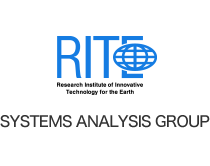Global Warming Research & Analyses
Assessment of Japan's Energy Mix and INDCs, long-term targets
2050 Targets
The Paris Agreement was adopted at the COP21 in December 2015 in Paris, where, regarding long-term targets, articles such as to hold the increase in the global average temperature to well below 2C above pre-industrial levels are included.
In Japan, The Fourth Basic Environmental Plan (2012) aims the emissions reduction target of 80% by 2050, and active discussion about long-term target is anticipated towards planning of long-term development scenarios hereafter.
For the contribution to such discussion, this report conducts quantitative analysis.
As for required emission reductions of Japan for 2050 in consistency with the 2C target, the estimates varies widely and is between 0% to 77% relative to 2010. In addition, the CO2 marginal abatement costs were estimated to be around $6000/tCO2 and annual costs of mitigation from BAU were 43-72 trillion JPY for the target of 80% reduction in 2050.
(Released on March 2, 2016)
2030 Targets
Discussions over post-2020 GHG emissions reductions are still ongoing worldwide, as it is hoped to reach an international agreement at the COP21 in December 2015. In advance of the COP21, participating countries are requested to submit their INDCs (Intended Nationally Determined Contributions), and some of them like the US or the EU have already submitted theirs to the Executive Office of the UNFCCC by the end of March 2015.
In this context, the Japanese government submitted the drafted energy mix for 2030 and GHG emissions reduction targets draft (INDCs) to the government council at the end of April, 2015.
This presentation offers a quantitative analysis of Japan's INDCs on several points identified as essential to the future discussion.
Power generation mix in the Government's energy mix plan can be regarded as almost reasonable in terms of seeking a balance among 3E+S (energy security, economic efficiency, environment and safety). In terms of energy projection, however, it might be unprecedentedly challenging, as the projection of increase in electricity demand is suppressed to 0.1% while GDP growth is forecasted to be 1.7% (GDP elasticity: 0.05).
Seen from various index, GHG emission reduction target in Japan can be evaluated as superior than those in INDCs from other major countries. But it might be too ambitious due to large expectations for energy efficiency countermeasures (extremely higher target of CO2 marginal abatement cost than other countries), that would generate concern about its viability. From a perspective of international competitiveness of industries, this shall be also noted. From the relationship with the target of halving global emission reduction by 2050, this reduction target will be sufficient.
(Released on June 2, 2015)
Analysis and assessment are updated according to the submission of INDCs from China or South Korea to UNFCCC, as well as to the official decision of INDC and its submission to UNFCCC on July 7 by Japan.
(Released on August 18, 2015)
- Assessment of Japan's Energy Mix and INDCs(PDF file:1,009KB)
RITE is participating MILES (Modelling and Informing Low Emissions Strategies), an international comparison project of modeling, where Japan's INDC has been analyzed and evaluated by RITE and National Institute for Environmental Studies(NIES). In the report, both NIES and RITE have concluded that emission reduction target in Japan's INDC is severe.
(Released on November 19, 2015)

